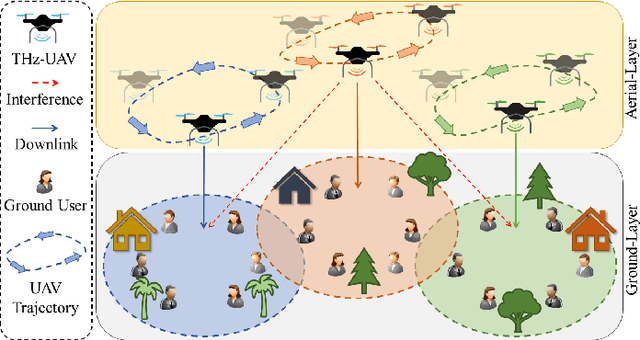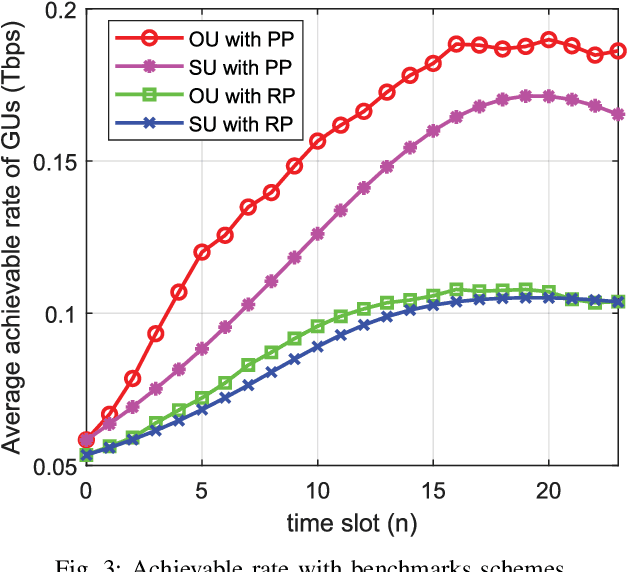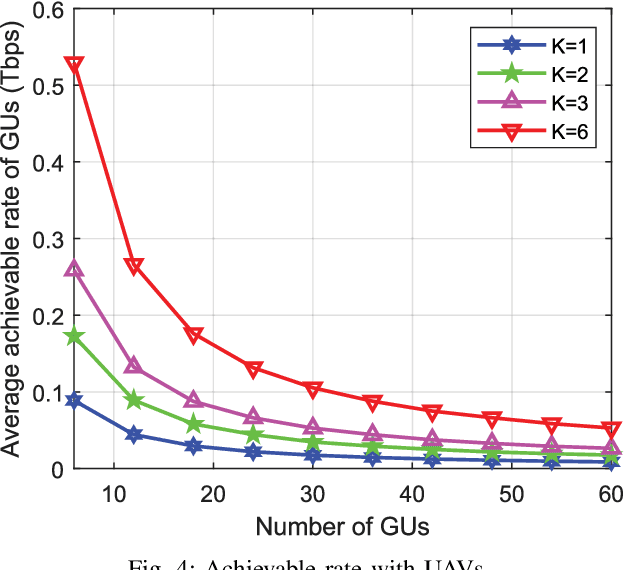Yu Min Park
Resource-Efficient Beam Prediction in mmWave Communications with Multimodal Realistic Simulation Framework
Apr 07, 2025Abstract:Beamforming is a key technology in millimeter-wave (mmWave) communications that improves signal transmission by optimizing directionality and intensity. However, conventional channel estimation methods, such as pilot signals or beam sweeping, often fail to adapt to rapidly changing communication environments. To address this limitation, multimodal sensing-aided beam prediction has gained significant attention, using various sensing data from devices such as LiDAR, radar, GPS, and RGB images to predict user locations or network conditions. Despite its promising potential, the adoption of multimodal sensing-aided beam prediction is hindered by high computational complexity, high costs, and limited datasets. Thus, in this paper, a resource-efficient learning approach is proposed to transfer knowledge from a multimodal network to a monomodal (radar-only) network based on cross-modal relational knowledge distillation (CRKD), while reducing computational overhead and preserving predictive accuracy. To enable multimodal learning with realistic data, a novel multimodal simulation framework is developed while integrating sensor data generated from the autonomous driving simulator CARLA with MATLAB-based mmWave channel modeling, and reflecting real-world conditions. The proposed CRKD achieves its objective by distilling relational information across different feature spaces, which enhances beam prediction performance without relying on expensive sensor data. Simulation results demonstrate that CRKD efficiently distills multimodal knowledge, allowing a radar-only model to achieve $94.62\%$ of the teacher performance. In particular, this is achieved with just $10\%$ of the teacher network's parameters, thereby significantly reducing computational complexity and dependence on multimodal sensor data.
Towards Satellite Non-IID Imagery: A Spectral Clustering-Assisted Federated Learning Approach
Oct 17, 2024Abstract:Low Earth orbit (LEO) satellites are capable of gathering abundant Earth observation data (EOD) to enable different Internet of Things (IoT) applications. However, to accomplish an effective EOD processing mechanism, it is imperative to investigate: 1) the challenge of processing the observed data without transmitting those large-size data to the ground because the connection between the satellites and the ground stations is intermittent, and 2) the challenge of processing the non-independent and identically distributed (non-IID) satellite data. In this paper, to cope with those challenges, we propose an orbit-based spectral clustering-assisted clustered federated self-knowledge distillation (OSC-FSKD) approach for each orbit of an LEO satellite constellation, which retains the advantage of FL that the observed data does not need to be sent to the ground. Specifically, we introduce normalized Laplacian-based spectral clustering (NLSC) into federated learning (FL) to create clustered FL in each round to address the challenge resulting from non-IID data. Particularly, NLSC is adopted to dynamically group clients into several clusters based on cosine similarities calculated by model updates. In addition, self-knowledge distillation is utilized to construct each local client, where the most recent updated local model is used to guide current local model training. Experiments demonstrate that the observation accuracy obtained by the proposed method is separately 1.01x, 2.15x, 1.10x, and 1.03x higher than that of pFedSD, FedProx, FedAU, and FedALA approaches using the SAT4 dataset. The proposed method also shows superiority when using other datasets.
Enhancing Spectrum Efficiency in 6G Satellite Networks: A GAIL-Powered Policy Learning via Asynchronous Federated Inverse Reinforcement Learning
Sep 27, 2024Abstract:In this paper, a novel generative adversarial imitation learning (GAIL)-powered policy learning approach is proposed for optimizing beamforming, spectrum allocation, and remote user equipment (RUE) association in NTNs. Traditional reinforcement learning (RL) methods for wireless network optimization often rely on manually designed reward functions, which can require extensive parameter tuning. To overcome these limitations, we employ inverse RL (IRL), specifically leveraging the GAIL framework, to automatically learn reward functions without manual design. We augment this framework with an asynchronous federated learning approach, enabling decentralized multi-satellite systems to collaboratively derive optimal policies. The proposed method aims to maximize spectrum efficiency (SE) while meeting minimum information rate requirements for RUEs. To address the non-convex, NP-hard nature of this problem, we combine the many-to-one matching theory with a multi-agent asynchronous federated IRL (MA-AFIRL) framework. This allows agents to learn through asynchronous environmental interactions, improving training efficiency and scalability. The expert policy is generated using the Whale optimization algorithm (WOA), providing data to train the automatic reward function within GAIL. Simulation results show that the proposed MA-AFIRL method outperforms traditional RL approaches, achieving a $14.6\%$ improvement in convergence and reward value. The novel GAIL-driven policy learning establishes a novel benchmark for 6G NTN optimization.
Design Optimization of NOMA Aided Multi-STAR-RIS for Indoor Environments: A Convex Approximation Imitated Reinforcement Learning Approach
Jun 19, 2024



Abstract:Sixth-generation (6G) networks leverage simultaneously transmitting and reflecting reconfigurable intelligent surfaces (STAR-RISs) to overcome the limitations of traditional RISs. STAR-RISs offer 360-degree full-space coverage and optimized transmission and reflection for enhanced network performance and dynamic control of the indoor propagation environment. However, deploying STAR-RISs indoors presents challenges in interference mitigation, power consumption, and real-time configuration. In this work, a novel network architecture utilizing multiple access points (APs) and STAR-RISs is proposed for indoor communication. An optimization problem encompassing user assignment, access point beamforming, and STAR-RIS phase control for reflection and transmission is formulated. The inherent complexity of the formulated problem necessitates a decomposition approach for an efficient solution. This involves tackling different sub-problems with specialized techniques: a many-to-one matching algorithm is employed to assign users to appropriate access points, optimizing resource allocation. To facilitate efficient resource management, access points are grouped using a correlation-based K-means clustering algorithm. Multi-agent deep reinforcement learning (MADRL) is leveraged to optimize the control of the STAR-RIS. Within the proposed MADRL framework, a novel approach is introduced where each decision variable acts as an independent agent, enabling collaborative learning and decision-making. Additionally, the proposed MADRL approach incorporates convex approximation (CA). This technique utilizes suboptimal solutions from successive convex approximation (SCA) to accelerate policy learning for the agents, thereby leading to faster environment adaptation and convergence. Simulations demonstrate significant network utility improvements compared to baseline approaches.
Joint UAV Deployment and Resource Allocation in THz-Assisted MEC-Enabled Integrated Space-Air-Ground Networks
Jan 21, 2024Abstract:Multi-access edge computing (MEC)-enabled integrated space-air-ground (SAG) networks have drawn much attention recently, as they can provide communication and computing services to wireless devices in areas that lack terrestrial base stations (TBSs). Leveraging the ample bandwidth in the terahertz (THz) spectrum, in this paper, we propose MEC-enabled integrated SAG networks with collaboration among unmanned aerial vehicles (UAVs). We then formulate the problem of minimizing the energy consumption of devices and UAVs in the proposed MEC-enabled integrated SAG networks by optimizing tasks offloading decisions, THz sub-bands assignment, transmit power control, and UAVs deployment. The formulated problem is a mixed-integer nonlinear programming (MILP) problem with a non-convex structure, which is challenging to solve. We thus propose a block coordinate descent (BCD) approach to decompose the problem into four sub-problems: 1) device task offloading decision problem, 2) THz sub-band assignment and power control problem, 3) UAV deployment problem, and 4) UAV task offloading decision problem. We then propose to use a matching game, concave-convex procedure (CCP) method, successive convex approximation (SCA), and block successive upper-bound minimization (BSUM) approaches for solving the individual subproblems. Finally, extensive simulations are performed to demonstrate the effectiveness of our proposed algorithm.
Joint User Pairing and Beamforming Design of Multi-STAR-RISs-Aided NOMA in the Indoor Environment via Multi-Agent Reinforcement Learning
Nov 17, 2023



Abstract:The development of 6G/B5G wireless networks, which have requirements that go beyond current 5G networks, is gaining interest from academia and industry. However, to increase 6G/B5G network quality, conventional cellular networks that rely on terrestrial base stations are constrained geographically and economically. Meanwhile, NOMA allows multiple users to share the same resources, which improves the spectral efficiency of the system and has the advantage of supporting a larger number of users. Additionally, by intelligently manipulating the phase and amplitude of both the reflected and transmitted signals, STAR-RISs can achieve improved coverage, increased spectral efficiency, and enhanced communication reliability. However, STAR-RISs must simultaneously optimize the amplitude and phase shift corresponding to reflection and transmission, which makes the existing terrestrial networks more complicated and is considered a major challenging issue. Motivated by the above, we study the joint user pairing for NOMA and beamforming design of Multi-STAR-RISs in an indoor environment. Then, we formulate the optimization problem with the objective of maximizing the total throughput of MUs by jointly optimizing the decoding order, user pairing, active beamforming, and passive beamforming. However, the formulated problem is a MINLP. To address this challenge, we first introduce the decoding order for NOMA networks. Next, we decompose the original problem into two subproblems, namely: 1) MU pairing and 2) Beamforming optimization under the optimal decoding order. For the first subproblem, we employ correlation-based K-means clustering to solve the user pairing problem. Then, to jointly deal with beamforming vector optimizations, we propose MAPPO, which can make quick decisions in the given environment owing to its low complexity.
SpaceRIS: LEO Satellite Coverage Maximization in 6G Sub-THz Networks by MAPPO DRL and Whale Optimization
Jul 28, 2023Abstract:Satellite systems face a significant challenge in effectively utilizing limited communication resources to meet the demands of ground network traffic, characterized by asymmetrical spatial distribution and time-varying characteristics. Moreover, the coverage range and signal transmission distance of low Earth orbit (LEO) satellites are restricted by notable propagation attenuation, molecular absorption, and space losses in sub-terahertz (THz) frequencies. This paper introduces a novel approach to maximize LEO satellite coverage by leveraging reconfigurable intelligent surfaces (RISs) within 6G sub-THz networks. The optimization objectives encompass enhancing the end-to-end data rate, optimizing satellite-remote user equipment (RUE) associations, data packet routing within satellite constellations, RIS phase shift, and ground base station (GBS) transmit power (i.e., active beamforming). The formulated joint optimization problem poses significant challenges owing to its time-varying environment, non-convex characteristics, and NP-hard complexity. To address these challenges, we propose a block coordinate descent (BCD) algorithm that integrates balanced K-means clustering, multi-agent proximal policy optimization (MAPPO) deep reinforcement learning (DRL), and whale optimization (WOA) techniques. The performance of the proposed approach is demonstrated through comprehensive simulation results, exhibiting its superiority over existing baseline methods in the literature.
Dependency Tasks Offloading and Communication Resource Allocation in Collaborative UAVs Networks: A Meta-Heuristic Approach
Aug 16, 2022



Abstract:In recent years, unmanned aerial vehicles (UAVs) assisted mobile edge computing systems have been exploited by researchers as a promising solution for providing computation services to mobile users outside of terrestrial infrastructure coverage. However, it remains challenging for the standalone MEC-enabled UAVs in order to meet the computation requirement of numerous mobile users due to the limited computation capacity of their onboard servers and battery lives. Therefore, we propose a collaborative scheme among UAVs so that UAVs can share the workload with idle UAVs. Moreover, current task offloading strategies frequently overlook task topology, which may result in poor performance or even system failure. To address the problem, we consider offloading tasks consisting of a set of sub-tasks, and each sub-task has dependencies on other sub-tasks, which is practical in the real world. Sub-tasks with dependencies need to wait for the resulting signal from preceding sub-tasks before being executed. This mechanism has serious effects on the offloading strategy. Then, we formulate an optimization problem to minimize the average latency experienced by users by jointly controlling the offloading decision for dependent tasks and allocating the communication resources of UAVs. The formulated problem appears to be NP-hard and cannot be solved in polynomial time. Therefore, we divide the problem into two sub-problems: the offloading decision problem and the communication resource allocation problem. Then a meta-heuristic method is proposed to find the sub-optimal solution of the task offloading problem, while the communication resource allocation problem is solved by using convex optimization. Finally, we perform substantial simulation experiments, and the result shows that the proposed offloading technique effectively minimizes the average latency of users, compared with other benchmark schemes.
3TO: THz-Enabled Throughput and Trajectory Optimization of UAVs in 6G Networks by Proximal Policy Optimization Deep Reinforcement Learning
Feb 07, 2022



Abstract:Next-generation networks need to meet ubiquitous and high data-rate demand. Therefore, this paper considers the throughput and trajectory optimization of terahertz (THz)-enabled unmanned aerial vehicles (UAVs) in the sixth-generation (6G) communication networks. In the considered scenario, multiple UAVs must provide on-demand terabits per second (TB/s) services to an urban area along with existing terrestrial networks. However, THz-empowered UAVs pose some new constraints, e.g., dynamic THz-channel conditions for ground users (GUs) association and UAV trajectory optimization to fulfill GU's throughput demands. Thus, a framework is proposed to address these challenges, where a joint UAVs-GUs association, transmit power, and the trajectory optimization problem is studied. The formulated problem is mixed-integer non-linear programming (MINLP), which is NP-hard to solve. Consequently, an iterative algorithm is proposed to solve three sub-problems iteratively, i.e., UAVs-GUs association, transmit power, and trajectory optimization. Simulation results demonstrate that the proposed algorithm increased the throughput by up to 10%, 68.9%, and 69.1% respectively compared to baseline algorithms.
Trajectory Optimization and Phase-Shift Design in IRS Assisted UAV Network for High Speed Trains
Jul 02, 2021



Abstract:The recent trend towards the high-speed transportation system has spurred the development of high-speed trains (HSTs). However, enabling HST users with seamless wireless connectivity using the roadside units (RSUs) is extremely challenging, mostly due to the lack of line of sight link. To address this issue, we propose a novel framework that uses intelligent reflecting surfaces (IRS)-enabled unmanned aerial vehicles (UAVs) to provide line of sight communication to HST users. First, we formulate the optimization problem where the objective is to maximize the minimum achievable rate of HSTs by jointly optimizing the trajectory of UAV and the phase-shift of IRS. Due to the non-convex nature of the formulated problem, it is decomposed into two subproblems: IRS phase-shift problem and UAV trajectory optimization problem. Next, a Binary Integer Linear Programming (BILP) and a Soft Actor-Critic (SAC) are constructed in order to solve our decomposed problems. Finally, comprehensive numerical results are provided in order to show the effectiveness of our proposed framework.
 Add to Chrome
Add to Chrome Add to Firefox
Add to Firefox Add to Edge
Add to Edge